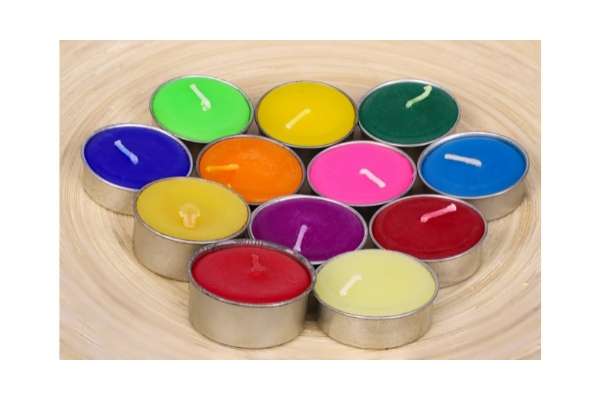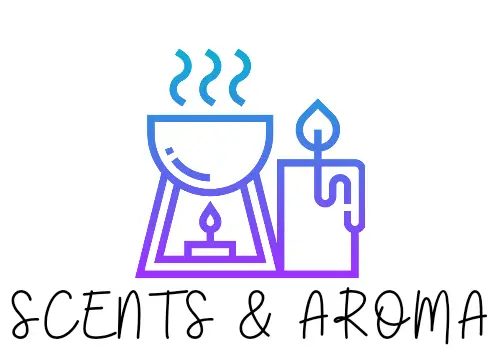Store-bought candles are convenient, but they can’t beat how it feels to light a candle that you have made, colored, scented, and poured yourself. These days, more and more people are looking for ways to dye their candles more naturally, especially if they’re using a natural wax like beeswax or soy wax. In this article, we’ll look at four different ways to colorcandles naturally.

Which types of wax work best?
Before looking at ways to color candles, we’ll first take a lookat the types of wax to use. Many people looking for natural colors often want a natural wax too like soy wax, beeswax,and palm wax. These waxes work differently when it comes to coloring them and soy wax is the most popular choice.
Soy wax
Derived from soya beans, soy wax is a great wax for making container candles as it is softer. You won’t find many pilar candles made out of soy wax, for example! With its low melting point and excellent scent distribution, soy wax is ideal for making natural candles.
Palm wax
Made from palm oil, palm wax is a natural wax that is much more suited to being used in pilar candles as it sets much harder.
Beeswax
Beeswax is most often made into natural, rolled candles but you can also use it to make container candles. For this, you’ll need pure and filtered beeswax.
For a more in-depth look at all of the different wax types and their benefits and negatives, check out the helpful guide that I wrote.
Now we’ve looked at the waxes, it’s time to look at how to color candles naturally.
The 4 best ways to color candles naturally
Below are 4 of the best ways that you can dye your candle wax with natural color. If you would like to cheat you can actually buy natural candle dye selection packs like these available on Amazon, this will save a lot of time and effort!
1. Coloring candles with natural dyes
As their name suggests, these dyes aren’t synthetic. This means the pigments are extracted from minerals or plants instead of being man-made. Some plants are better than others and many different plant parts are used to make dyes, including the petals, roots, and stamens.
Making natural dyes takes a lot of time, so patience is required. It can take up to 48 hours to get the color to the saturation that you desire.
2. Using flowers and plants
Before synthetic dyes existed, herbs and plants were used as dyes. Herbs can be heated in an oil in order to extract their color or they can be added directly to hot wax, but straining the wax to remove parts of the plant is necessary before dipping the candles.
Lots of flower petals and plants can be used as a natural dye. You can also add petals to candle wax to add texture too. Let’s look at some plants and flowers and the colors they produce.
Red
Hibiscus flowers, St. John’s Wort and Rosehips (dark-coloredones) will give soy wax a reddish color.
Brown
Goldenrod and coneflower will produce brown candles as will green tea. It’s not necessary to seep the green tea, crushing the leaves is enough.
Henna, on the other hand, will make a lovely olive brown-green earthy color while sage develops a brown that’s more green
Pink
For a pink tint, go for lavender and roses
Blue
If you’d like to dye a candle with a natural blue, go for hyacinth and cornflower flowers. Indigo is another great dye that has been used to dye fabric for years!
Red-purple
For a slightly deeper, almost purple red, daylilies and safflowers are an excellent choice for your natural candle wax dye.
Peach
Virginia creepers will make a beautiful peach color.
Green
Snapdragons and foxgloves are great for adding a green tint to your natural candles. Others include nettles, kelp, parsley, rosemary, alfalfa, and wheatgrass also offer a variety of green shades.
Yellow
Yellow shades can be created with yellow safflowers.
Beige
For subtler, beige tones, chamomile flowers are great. You could even use plain chamomile tea!
3. Using spices
If you add spices to hot wax, you’ll have some great scents as well as great colors! These can even be used as aromatherapy candles. For these candles, expect the spice to act like a pigment rather than a dye, particularly if you use powdered spices.
Orange
For an orange tint, add sassafras or turmeric. You can get a dark orange color with ground paprika.
Yellow
To achieve a yellow color with spices you have a few options including ground annatto seeds, turmeric, and saffron.
Beige
Both madder root (chopped, sliced or dried) and vanilla pods create a lovely beige color. Don’t use vanilla essence though, just actual dried pods.
Red
Alkanet root belongs to the borage family. Chopped, sliced, or powdered alkanet gives the wax a red color.
Brown
Crushed whole cloves create a lovely brown candle while cinnamon (ground or quills) give you a light, warm brown.
Green
If you want to create a green color wax with herbs, spirulina is a great one. It is easy to achieve a sea green. Experiment until you get the shade you like.
4. Using fruit and vegetables
Another way of dying candle wax is to use fruits and vegetables. Just like blackberries can stain fingers, they can be used as a dye!
Green
Artichokes create a wonderful green.
Reddish purple
Huckleberries
Blueish purple
Blackberries, elderberries and blue betties
Pink
Strawberries, cherries and raspberries.
Yellow
Lemon peel creates a lovely yellow color as you’d expect. The color produced is almost pastel in shade.
Dark brown
Beetroot is definitely a vegetable that stains and so it’s great for coloring candle wax. It doesn’t, though, produce so much of a red color as a brown. It’s an appealing shade though!
Orange
Onion skins and orange peel can be used to give wax an orange tint. You can also use carrots, which have a really impressive orange color!
Final thoughts on how to color candles naturally.
We’ve seen how you can color your wax naturally with synthetic dyes, flowers and plants, spices, and fruits and vegetables. The great thing about making your own candles is that you can experiment. Lots of the items we’ve mentioned in this article you might already have around the house!
- Can You Put Perfume In A Humidifier? (Read First) - September 17, 2022
- Can You Put Essential Oil In A Steam Mop? (Safety Advice) - September 17, 2022
- How To Make Lavender Oil At Home ( Candles And Diffusers) - September 9, 2022
